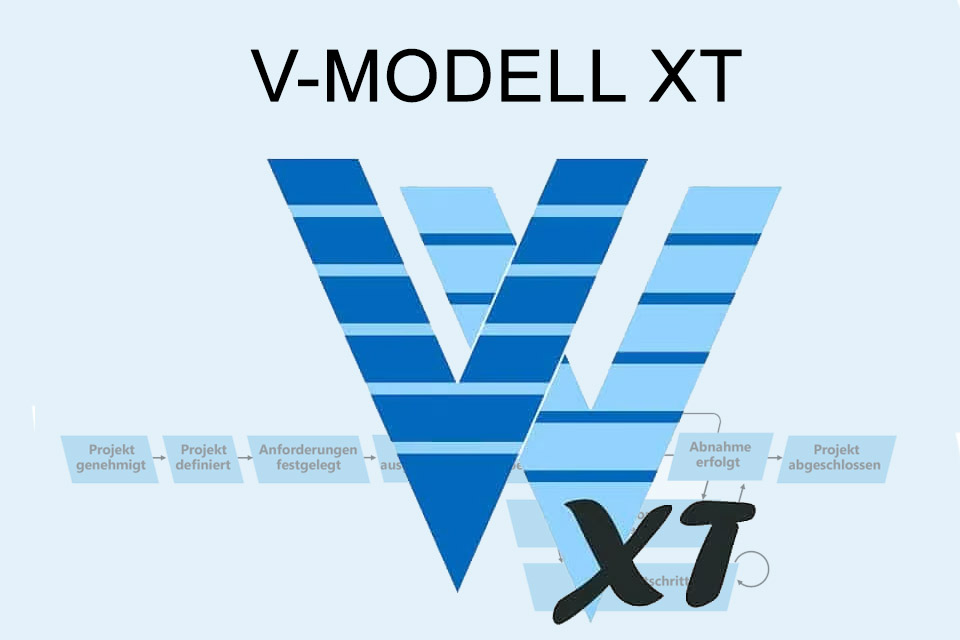What is the V-Modell XT?
Smartpedia: The V-Modell XT is a German standard for the planning and implementation of system development projects. It is aimed at both clients and contractors.
V-Modell XT – a rich model for system development
The V-Modell XT is used in companies, authorities and the military for planning and execution of system development projects. As a German standard, it is aimed at both customers and contractors. Since it is a very extensive and well documented procedure, it is also referred to as a rich model for system development.
The maintenance and ongoing development is coordinated by Weit e.V. The V-Modell was first published by the German Armed Forces in 1992. Since then there have been two revisions: V-Modell 97 and V-Modell XT. The development of V-Modell XT involved scientific research, the private sector and the public sector in equal measure. The current version is 2.3.
Basic concepts in V-Modell XT
The V-Modell XT defines some basic concepts or terms that are essential for understanding and application:
- Tailoring
Since the V-Modell XT is applicable in many constellations, it must be tailored to the specific project at the beginning of the project. This is called tailoring. The addition “XT” to the V-Modell stands for “eXtreme Tailoring” and emphasises the adaptability of the model to specific project situations. - Project types
V-Modell XT classifies projects using project types and the role one party plays in a project (i.e. acquirer, supplier or both within an organisation). - Project type variants
In the project type variants, the general conditions for the course of the project are specified. They distinguish between a acquirer project or a supplier project, whether there is one or more suppliers or whether a new product is to be developed or an existing one maintained. - Products and Activities
In V-Modell XT, the results to be generated and intermediate results are referred to as products. Products are created by employees with defined roles and through precisely defined activities. A product can be subdivided into various topics; there can also be activities for these topics. Products and activities can be grouped into disciplines. - Process modules
The V-Modell XT is considered to be a rich, comprehensive process model. It defines process modules to improve project planning. A process module encapsulates activities, products and roles. - Project execution strategies
Process modules do not provide any information on the sequence of implementation of the project – it results from the project execution strategy and from the chronological arrangement of the decision gates. The project execution strategy is determined by the project type variant and the definition of project characteristics. - Decision gates
A decision gate is a milestone in a V-Modell XT project where a decision is made about the continuation of the project and the release of the next project phase. To pass through a decision gate, an assigned product must be available in a defined quality.
Innovations in V-Modell XT
With version 2.1, the procedure contained in V-Modell XT for the introduction and maintenance of organisation-specific process models was removed and implemented as an independent model (V-Modell XT ORG).
In version 2.2 the V-Modell XT was extended by aspects of information security guarantee, i.e. there were some additional project results for clients and contractors as well as various text examples for the design of the results.
In V-Modell XT Version 2.3, the product dependencies were redesigned. Products have defined dependencies which, for example, influence the generation of intermediate and final results and enable the traceability of information.
All changes to new versions are published in the V-Modell XT Release Notes on the website of the Federal Ministry of the Interior, for Construction and Home Affairs (BMI) or Weit e.V.. There are also release notes for the different variants
Advantages and disadvantages of V-Modell XT
There are different opinions on the advantages and disadvantages of the V-Modell XT. The following advantages are mentioned in the introduction to the current version:
- Improving communication between stakeholders
- Minimisation of project risks
- Guarantee of quality
- Containment of total costs over the entire project and system life lifecycle
- Improving information security
Each of these points can be discussed in detail. The same goes for the sometimes mentioned disadvantages:
- Complexity and scope of the model (the documentation is e.g. 213 Din-A4 pages long)
- Parallelisation of tasks is difficult
- Change requests cannot be easily integrated
- The delimitation of different project phases does not work in practice
- Focus on document creation is too great
And even on each of these points opinions can diverge.
Impulse to discuss
The V-Modell XT defines, among other things, an agile project execution strategy. How agile can a project be that is planned and controlled accordingly?
Notes:
If you like the article or would like to discuss it, please feel free to share it in your network. And if you have any comments, please do not hesitate to send us a message.
Here you can find the current V-Modell XT Version 2.3 in German here.
Here you can find information about V-Modell 97.
And here you can find additional information from our t2informatik Blog:



